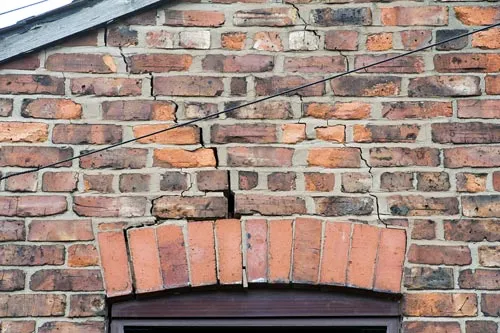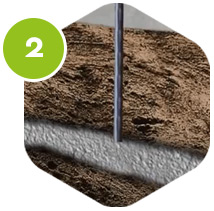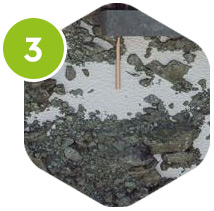Spotting The Signs Of Subsidence
Contents:
In its simplest terms, subsidence is when a building sinks to the ground. Foundations are no longer able to fully support the weight of a building.
It can be a nightmare for property owners. As such, identifying and catching any issues early is vital if you don’t want to be dealing with even bigger structural supports problems.
Identifying Subsidence
Subsidence is not without warning signs. Some of the most common include:
- Cracks in walls
- Sinking floors
- Windows and doors sticking
- Noticeable leaning of property
- Extension moving away from property
The major sign of subsidence is cracks in walls. Cracks caused by subsidence are normally of a diagonal nature and will suddenly appear in plaster work inside the building and on brickwork outside.
They will usually be thicker than fine hairline cracks, which may be caused by natural movement of a structure, and tend to be wider at the top.
Not all cracks are due to subsidence – fine, hairline cracks are usually nothing to worry about. Subsidence cracks to be wider than a ten pence piece.
Cracks caused by subsidence.
Think your property might be suffering from subsidence?
Geobear offers the fastest, most effective and most cost-saving subsidence solution available. Our patented technique requires no excavation: we can fix the problem in as little as one day!
Find out more about our non-disruptive subsidence solutions here
Clear Signs
Floors can drop. It’s quite clear to spot this – take a look at the skirting around the floor. If you find gaps, cracks or uneven surfaces your property is likely affected.
You can also look for possible signs of subsidence around weak points in the building, such as doors and windows. Doors and windows can stick or fail to open and close properly due to the building moving from its original foundations.
Building extensions can help detect whether subsidence is a problem. Subsidence cracks are common at points where an extension meets the main buildings, indicating that the extension is pulling away from the main structure and that an intervention may be required.
We can inject our geo-polymer material beneath an extension to stabilise it and prevent further movement, and in some cases also lift it back into place.
Treatment
The principle of our solution involves injecting one of our expanding geo-polymer materials under your property. The material is pumped into the soils as a liquid and expands under the ground.
As the geo-polymer expands it fills the voids in the soils, forces out any water and compacts the soil – this results in a solid stable base under your property’s foundations or floor.
As the material expands in the ground it will follow the path of least resistance until it cannot migrate any further. At this point, the expansive force of the material begins to push up onto the foundations of the property.
We can see when this happens using our laser monitors, which pick up 0.25mm of movement above the injection point.
If we are stabilising the ground we will stop the process at this injection point and move on to the next. We inject at points at around 1.5m apart to ensure the material is equally spread under the problem area of your property.
If lifting the floor, we continue injecting material at the injection point until the floor is lifted to the required level.
The material we use does not degrade — it is a permanent solution comparable to concrete. The process of introducing our geo-polymer to the affected area is faster and cleaner for all types of subsidence.
Cement grouting requires heavy machinery and your property becomes a full worksite. The same applies to screw pillars and underpinning.
They all require the excavation of foundation soil. With Geobear, we simply drill small holes and inject our material.
Using geo-polymer as a solution to subsidence is the most convenient method and in most cases the preferred option. Other methods, such as underpinning delivered by traditional building contractors, are becoming dated as modern technology evolves.
For Further Information…
Download Our FREE Subsidence Maps:
We’ve been producing subsidence maps to help us better understand the geographical spread of the issue in the UK.
The British Geographical society has a tool which highlights the type of soil throughout the UK, we mapped our own data to provide an interesting picture.
How is the soil and subsidence in your area? Check out your area, as well as others.
What Causes It?
A number of factors can play a part. These include:
- Soil type
- Ground below a property shrinking or expanding due to fluctuating weather or temperature
- Leaking drains
- Unstable foundations
- Tree roots
Soils
The biggest of these is soil shrinkage. In the UK, around 75% of insurance claims for subsidence are the result of shrinking soils.
Soils such as clay and silt are classed as cohesive soils. This means that when wet and dry, they hold have a capacity to swell and shrink.
Foundations built on such surfaces can witness changes from day to day, month to month and season to season.
Soils such as sand and gravel are what are known as non-cohesive soils. Shrinking and swelling doesn’t occur with this soil type.
Unfortunately, they are not exempt from subsidence. They are made up of tiny particles which can erode and wash away over time.
Organic soils naturally decompose due to their makeup. Oxygen naturally shrinks particles resulting in a smaller load bearing capacity.
For more information on UK soil types, including detailed maps, visit the UKSO website.


Drainage Issues
Around 15-20% of subsidence claims are down to leaks from pipes and drains. Water seeping through and affecting the foundations can occur one of two ways.
Water makes the ground softer meaning that supporting soils lose some structural support. As a result, foundations begin to sink.
Water washes away non-cohesive soil particles meaning there simply isn’t the same volume that there was before.
Tree Roots
Trees, plants and shrubs spark in excess of 60% of claims. Big trees, in particular, are guilty of actively taking moisture away from foundation supporting soils if planted too close to a property.
Plants need to water in order to live and roots go in search of moisture. In areas of shrinkable cohesive soils, plants pose the risk of taking away so much water from foundation support that subsidence may occur.
As you might expect, different species absorb different amounts of water. As a general guideline to planting distances from a property, root length and tree height are around the same.
The Association of British Insurers (ABI) has a guide to tree height, root length and safe distances which can be found here.

How do we resolve subsidence in just 2 days?
Our Experts Drill Holes In The Affected Area
At just 16mm they’re typically the size of a 10p and often we don’t even need internal access
We Inject A Special Geo-Polymer Resin
In a quick and easy process we inject a special resin that will expand and harden to support the property.
The Resin Instantly Hardens Like Concrete
Within just 15 minutes the resin has expanded to fill any voids and stabilise the ground and is already 90% cured
The Property is Raised and Foundations Stabilised
You’ll see the results instantly. Often cracks disappear and doors unstick as we raise the property.
The Cost of Subsidence
Ground and land subsidence is a potentially catastrophic problem for your home or business.
From visual issues to more serious safety and financial implications, the problems caused by subsidence are wide-ranging. It is a problem that needs to be dealt with in a timely and professional manner.
Aesthetic Impact
Huge and horrible cracks creeping across your walls, plaster flaking off, wallpaper rucking at the edges and brickwork shifting out of place are all ways that subsidence can make your home or business look worn out and uninviting.
This not only makes the building look dramatically worse, it can naturally also lead to the fall in the value of your home, which could be devastating for you if you’re trying to sell it.
If you’re running a business, cracks in the walls and plaster crumbling off could potentially turn away customers and clients, leading to an unnecessary loss of revenue.
Catastrophic Consequences of Subsidence
As well as the threat to the look of your property, there is a multitude of other inconveniences, problems and disasters awaiting you if you don’t get your subsidence treated.
Doors and windows, which are structural weak points, might start getting stiff or stuck, due to distortion. Pipework and electrical wiring are also under threat from the sinking and movement of walls.
Did you know?Trees planted close to a building can suck the moisture from the supporting ground.
In your home, this can be annoying and unpleasant and in a business this can make parts of the building potentially unusable, leading to a waste of money.
If you notice issues with your plumbing or lights, then this could be a symptom of ground subsidence.
At the extreme end of potential problems is massive structural damage to your property.
If you start to notice significant structural damage, health and safety becomes a concern. This is obviously a potentially calamitous scenario for a home or a business.
Business property owners have the added threat of legal action potentially being taken against them if these risks ever become a reality. If parts of your building collapse, you might find yourself unable to use it, which leads to huge problems and costs for homeowners and business owners.
Financial Implications of Subsidence
On top of all that, there’s also the extensive repair costs which you may have to deal with if subsidence is left to get worse.
Structural damage to a building, its wiring and pipework can all potentially be enormous financial costs.
Importantly, these extensive repairs dwarf the cost of Geobear’s quick, clean and effective ground remediation solutions.
Untreated subsidence can lead to significant loss of property and structural value, as well as costs to your business from an inability to use your premises or structures for their planned purpose.
Why take the risk with your property? Do not leave it too late—it’s not worth it.
Did you know? Traditional underpinning costs have been known to run up to £50,000.
If you think your property may be impacted by subsidence issue, then give us a call to discuss how we can help. We may be able to give you a price estimate over the phone, or we can arrange a site inspection so we can understand the extent of your issues.
Contact Geobear Today
Please complete the details below or call us directly on 0800 084 3503.
Contact us








